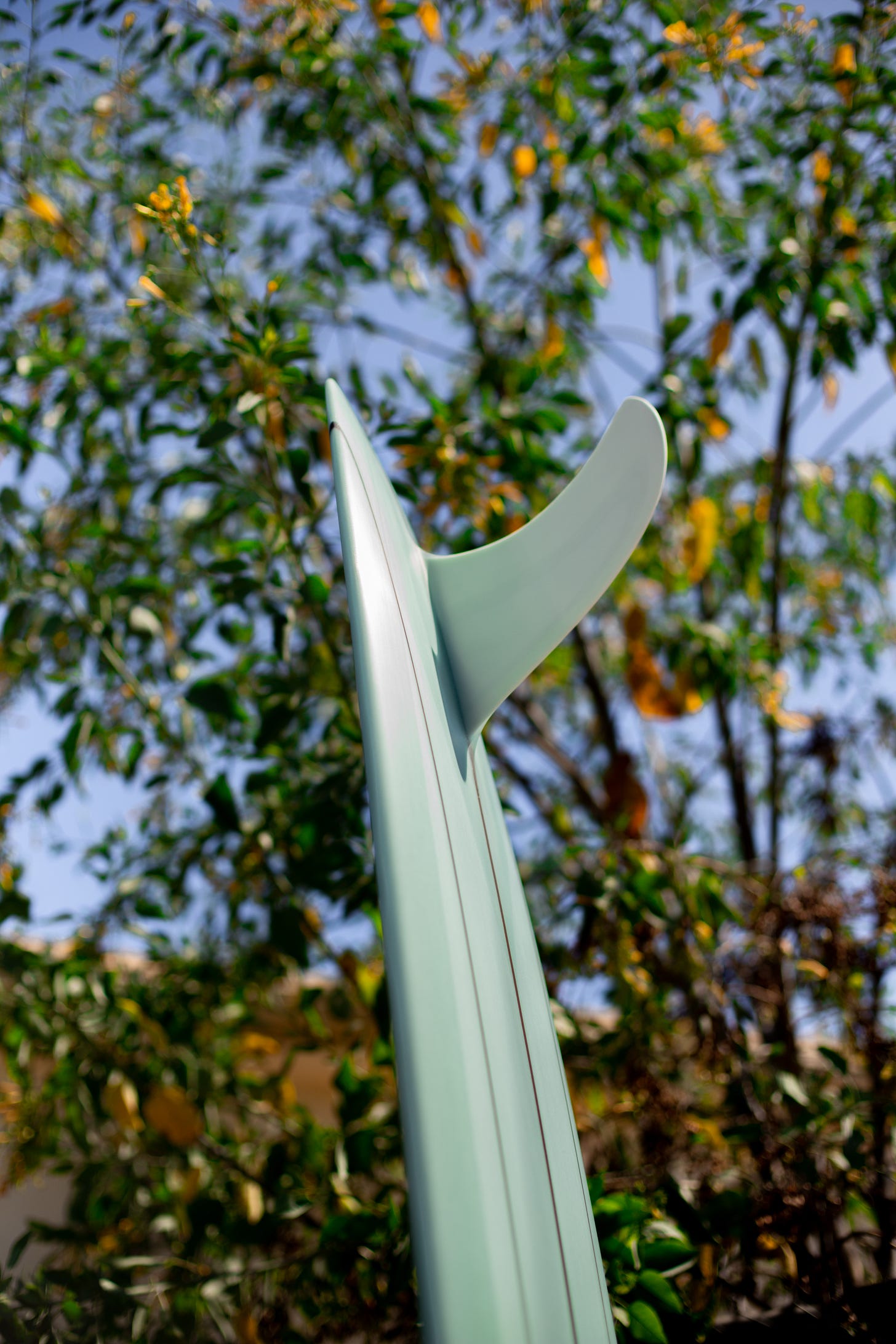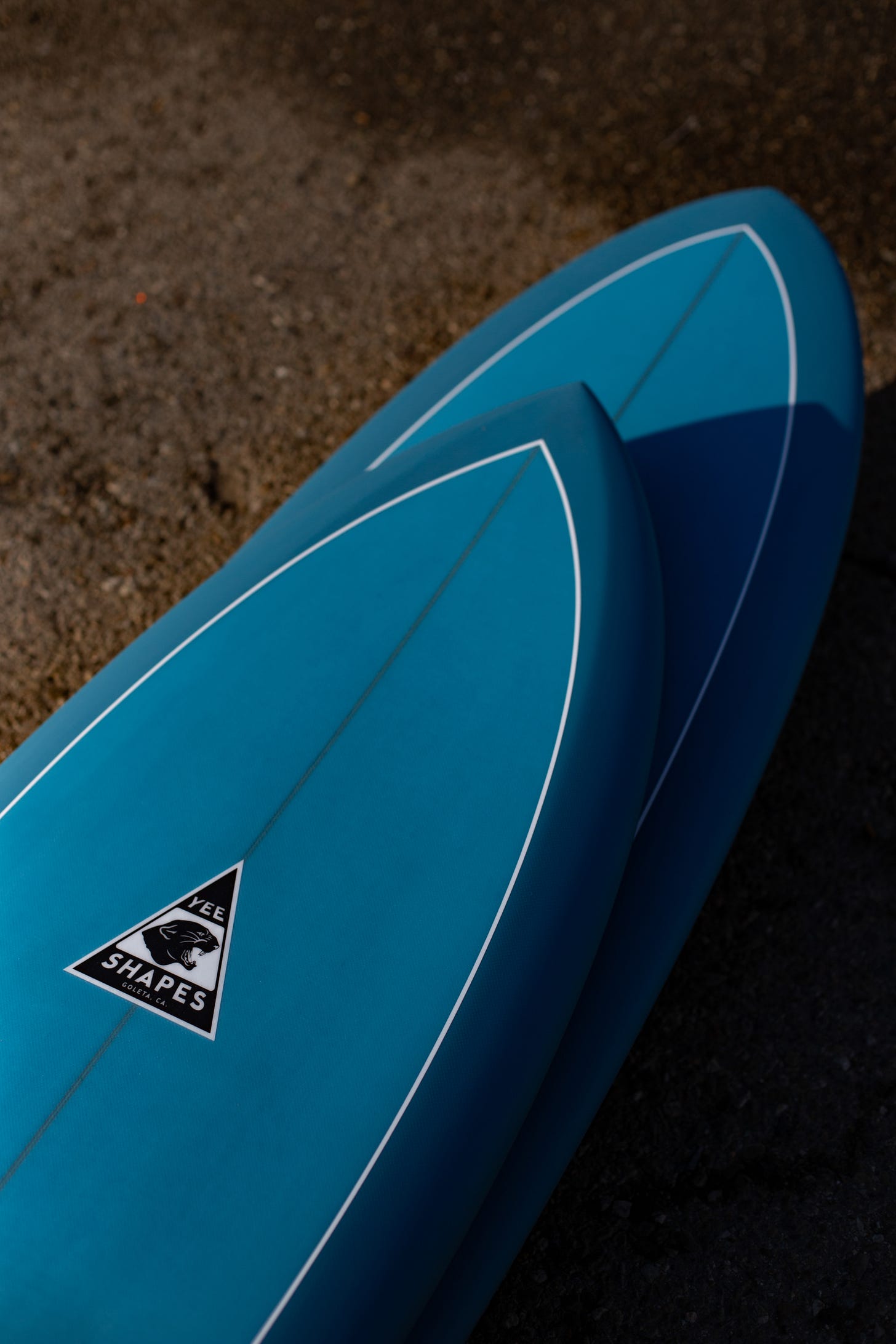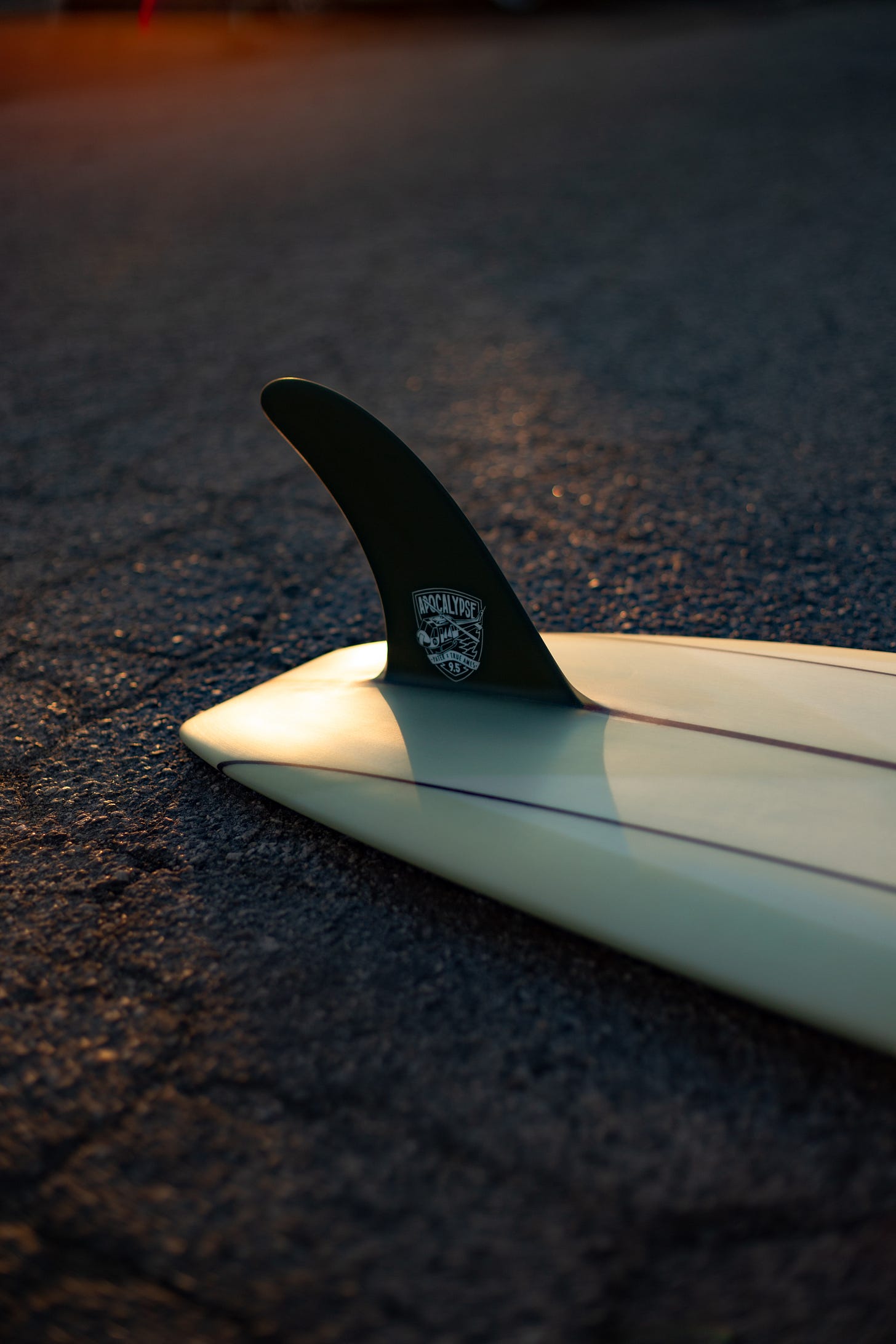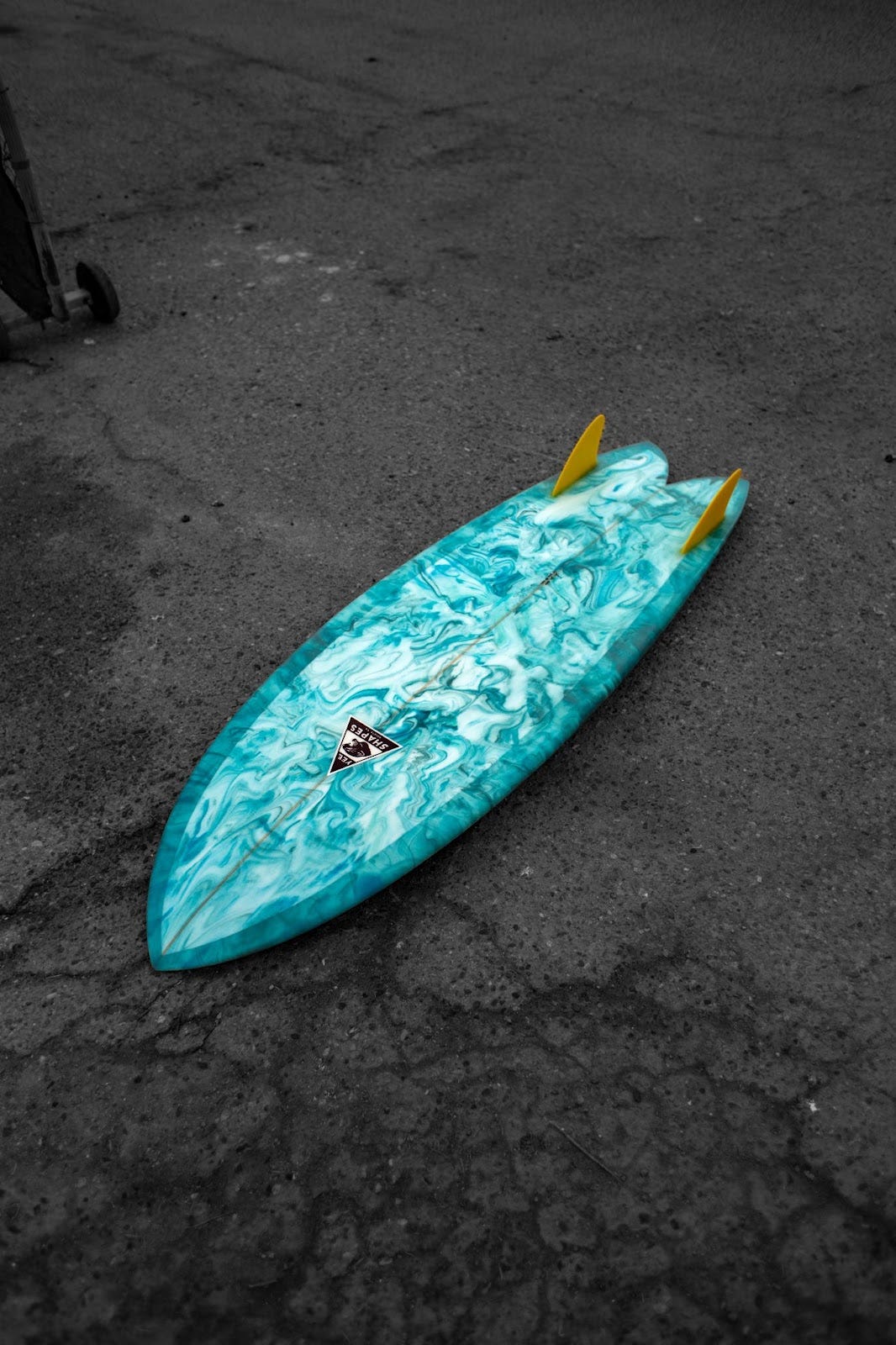Joseph and biz partner Yukon.
Every time an aircraft approaches Santa Barbara Airport, Joseph Yee can hear it. If the planer is running or the shop radio is cranking local classic-rock favorite KTYD too loud, he’ll probably just feel it shuddering the corrugated walls of the shop he built for himself. By now, he’s used to it and doesn't even pause from his work, whittling noses or laying up surreal tints quietly and efficiently. Yee’s style is subtle, understated-- like his surfing and his personality. He loves to have fun with a tripped out swirl or acid splash, but his best boards will have toned down single color tints. These, combined with relaxed rockers fit the under-the-radar vibes and slopier curves of his favorite waves. Take a step back and look at the surfboard industry as a whole, and you’ll realize how rare it actually is for a young person to master both hand-shaping and glassing, and to be running their own business for both. His work represents a fresh young take on the traditional model of independent craftsmen running the whole process of building a surfboard by hand. He may seem hemmed in working long hours in a low-lying industrial shack, but breathing life into foam and resin in a special corner of the world is as close to full circle as it gets for the 29-year old.
Yee came to surfing unconventionally, far from the prying eyes of parents or coaches. Around sixth grade, he would spend his after-school afternoons with his friend and their babysitter, renowned surfer Janna Irons. Irons would take them down to Rincon to teach the boys to surf and of course to catch a few waves herself. After successfully navigating the chaos of a head-high day in the Cove in his first session and graduating off his first board, the pink Water Angel soft top, Joseph felt motivated to stick with it. He was already skateboarding at the time, so it made the transition to hunting waves on the Goleta coast that much easier. After high school and 2 years at SBCC, he transferred to Azusa Pacific University to study photojournalism, only to return home after the first semester with a renewed sense of what was important: he needed to be surfing and he needed to be in Goleta. “It was 110 degrees on the first day of school, there was no way I was staying there.” he laments. This juncture is what brought him to shaping--he wanted to make boards that fit his unique style of surfing, and he couldn’t find them on the rack at shops, so he decided to make his own. He jokingly asked his dad if he could build a shaping room in the backyard, and to his surprise, the answer was yes. They built Joseph a little shed and got all the tools and he went to work, with very little prior knowledge and only youtube shaping tutorials to guide him.
“Everything I've ever done has been trial and error,” Says Joseph about his early days through to today. He continued to teach himself, making mostly personal boards and hooking up curious friends when they placed orders, always imagining that shaping and glassing were just a fun hobby. It was around board number 50 when hot local shaper Ryan Lovelace caught wind of what he was up to, and offered him a job on the spot. The two had known each other for a while, With Joseph having ridden some of Ryan's boards in the past. Lovelace’s business was taking off at the time, and he was in the midst of setting up Trimcraft, which would employ up-and-coming shapers to hand-shape Lovelace’s models. This would satisfy the growing demand for Ryan’s boards while keeping his hand-shaped ethos intact, plus bring vital new sets of hands into the industry and quietly prove to the world that hand-shaped boards can still satisfy mass production. Since Yee had mastered the basics of hand-shaping and glassing, he seemed like a perfect fit for the gig, and Ryan got him started right away. Yee attributes many of the detailed tricks of the trade that he knows to Lovelace, but he is clear that no one ever held his hand. When handing over some of his finished Trimcraft shapes to Lovelace he recalls, “I would have to force him to tell me what he was fixing on them and why, otherwise he would just do it.” Trimcraft gave Yee the opportunity to get numbers under his belt in those crucial early years, under the watchful gaze of a skilled mentor. Yee Shapes was still slowly forming one custom order at a time, and eventually Joseph was looking to take on more responsibility.
Joseph at work.
That opportunity came from Jeff Hull, who runs a fiberglassing outfit for both boats and surfboards in Ventura. Joseph took over the glass shop at Hull, and was able to use the adjoining shaping bay and all the interesting templates, curves, and dimensions left behind by past shapers, for his own boards. At Hull, he was able to learn production glassing techniques for the stock of mostly light and white shortboards, which was a departure from the opaque tints and sanded glosses of Trimcraft. Production-level work was the final missing piece to making Yee’s skills wholly well-rounded, and he knew he had basically earned journeyman status from his time in Ventura. He knew that the next step was to do his own thing, and from conversation with Lovelace, was re-connected to his current partner Jeff Svoboda. Joseph had ridden some of Svoboda’s boards back when Jeff was shaping out of an Isla Vista basement, was in a similar position looking to branch out from his longtime position glassing under Goleta master Bob Haakensen. Eventually they found an industrial building for rent in Goleta, off Fairvew road not far from where Jeff worked and Joe grew up. The pair jumped on it, and built out the space to have room for both of them to be able to shape, glass, and sand without getting in the way of the other. “There's no competition between us, we both have our own clientele and our own space. It works really well” Yee says of the relationship.
Joseph makes it clear that this current shop is the most important stage in his career, all because of it being located in his hometown of Goleta. His favorite pointbreak is a stone’s throw away, and he is finally able to serve the community he loves and offer quality options to his ideal customer: kids that were just like him growing up. “My parents couldn’t afford a brand new CI when I was a kid, and those are the people I want to be doing boards for, so I try to keep the cost down as much as I can,” he reasons. A custom order from Joe will (depending on color options) probably still run you less than a board off the rack at most local shops. In a surfboard industry that is increasingly automated, mass produced, and impersonal, Yee and Svoboda’s shop stands out as one of the few places where a customer can order a custom board directly from the person who will be creating it every step of the way. On most days, thats where youll find them, fulfilling custom orders and glassing requests from various local sources.Yee still gets steady glass work from Lovelace, whose newest venture Lovemachine, machine shaped versions of Ryan's most popular models, has once again taken off in order to satisfy the high demand for his boards. When asked about what he sees for the future of his business, he points to LoveMachine as the template. For expanding, the model can be tricky, he laments: “It's either you sell out and go full mass production (solely via shaping machine and outsourced glassing), or you're routing boxes when you’re 80 years old. I’m trying to take a different route from those two, and what Ryan did with Lovemachine is sick.” It would allow him to increase production, and offer more options to his customers while still keeping his hands on all parts of the business. There would still be a distinction between hand-shaped and machined in terms of name, dimensions and price.
The lesson here is to order a board from your local shaper. You’ll get better service and usually a better finished product. You'll be supporting your local economy and keeping a small business alive, but you'll also be establishing a connection between yourself and a member of your community. That connection, especially in a small town like Goleta, can come in handy in multitudes of ways, set waves of course being just one of them. The longstanding tradition in our small industry of doing things yourself, by hand, is kept alive by Joseph, Jeff and the rest of the dwindling underground. Mass production satisfies demand at the cost of connection: of customer to craftsman, of rider to plank, and most importantly of the surfboard to its rightful place as being a work of art with its own energy and personality. By choosing to spend your money with a truly independent shaper like Yee, you are revitalizing all those connections, plus your options for quality color and glassing are much, much broader. So, pick wisely.
Joseph’s work.









